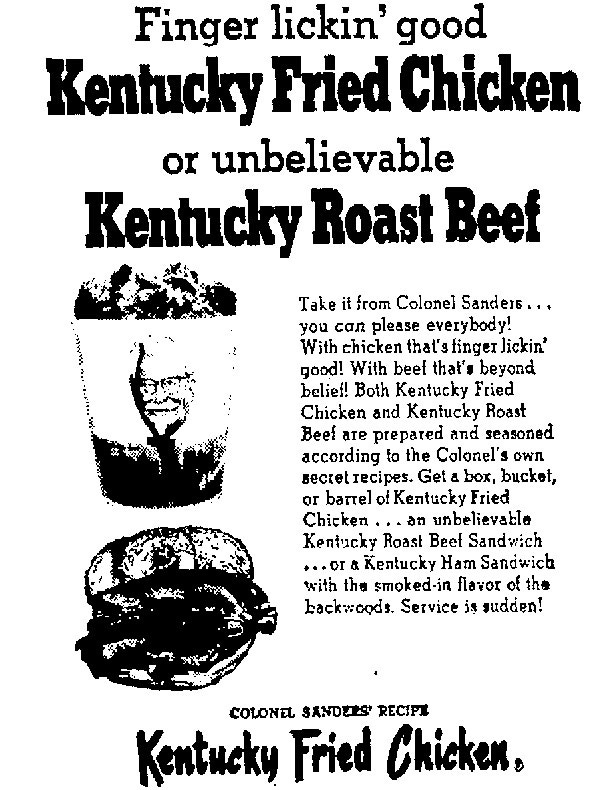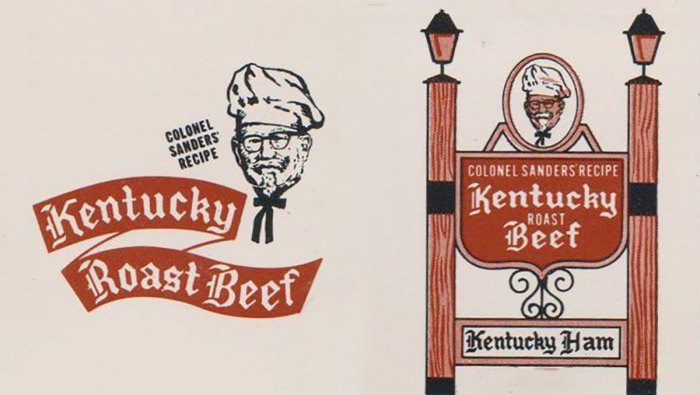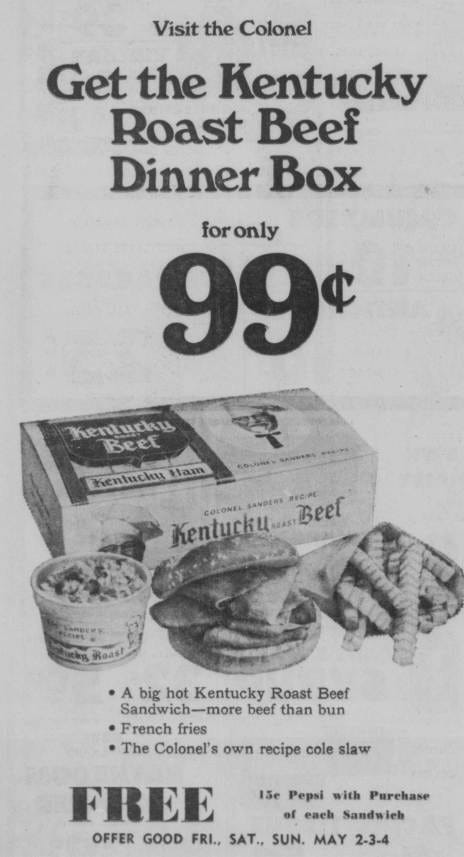Kentucky Roast Beef
We are all familiar with the massive fast-food chain, Kentucky Fried Chicken (KFC). It currently has over 24,000 locations and still appears to be growing. People seem to have a bottomless appetite for their chicken and they are riding that appetite to success. But success in any business is hard to maintain, this means that you need to take chances and try new things to open up new markets for growth.
We are familiar with KFC’s more modern crazy food experiments like the Double Down, but back in the 1960s, they decided to try a different route, Roast Beef. While this attempt was relatively short-lived, it was a much more successful attempt than what happened with McDonald’s brief foray into roast beef.
The Colonel Cashes Out (sorta)
KFC was founded by Colonel Harland Sanders. Sanders was a serial entrepeneur with a rough history. He was also a hard worker who knew how to make delicious fried chicken.
He launched the first franchised KFC restaurant in South Salt Lake, Utah. It was a huge hit and with Sanders’ natural knack for showmanship and a quality product, the chain grew quickly. In just over a decade the number of outlets had grown to 600.
In 1964 Sanders decided to sell the outfit to a group of investors led by John Y. Brown Jr. and Jack C. Massey for the bargain price of 2 million dollars. They would retain Sanders as the spokesperson and quality control expert. This would come to be a role he both relished and hated. He liked the attention and association with the brand, but didn’t like the direction the company took or the money he missed out on by selling when he did.
With the Colonel still front and center as a figurehead, but with new people streamlining the business, growth went into overdrive.
A Chicken Juggernaut
By 1967, KFC was the sixth-largest restaurant chain in the United States. In 1968 they were riding high with 1,700 outlets. Of those restaurants, 1,200 of those locations had been added in just the last 4 years. It went public in 1966 and its stock responded to this growth and soared. Three years later it would be listed officially on the New York Stock Exchange in 1969.
These were heady times, but not without worry for the chicken-fried behemoth. Direct rivals like Church’s Chicken were growing and the powerhouse chicken adjacent restaurant Chik-Fil-A was looming on the horizon.
This growth was not without controversy. By 1970, an unnamed member of KFC’s senior management was bold enough to describe KFC’s international strategy as “throwing some mud against the map on the wall, and hoping some of it would stick.”
You might think the smart thing to do would be to continue to refine the process and innovate on what they were good at, which was chicken, but the brass at KFC had a different idea, diversify. So in March of 1968, Kentucky Roast Beef and Ham was born.
The First Location
With the new restaurant brand, KFC wanted to make a splash. So what better place to test the store than in Swingin’ Sixties Las Vegas.
The building out of this new restaurant and the expansion of the brand was put in the capable hands of Kent Prestwich. Prestwich had built and run 23 successful KFC retail outlets over the course of five years before being named an executive vice president at the company.
The Vegas test outlet under his guidance was a rousing success. According to William Hay in his 1968 article, Country Stars Count Their Chicken, “during the first 30 days it ran up $70,000 of sandwich sales.” This was significant enough for the company to buy in completely.
With the pilot location a rousing success, it officially came out of test mode and in mid-1968 Kentucky Roast Beef was unleashed upon the world. The growth was explosive with 100 outlets opening in just two years.
Kentucky Roast Beef ‘n’ Ham
The name of these restaurants can be a little confusing because at the same time they started selling Kentucky Roast Beef, they were also selling Kentucky Ham. So some outlets were called Kentucky Roast Beef ‘n’ Ham while others would just include an extra sign that said, Kentucky Ham.
It could have been even more confusing. The Company also tested Kentucky Ribs and Kentucky Fish. Lucky for us those offerings never made it to the sign.
The Roast Beef was slow-cooked and served on a buttered bun. Its tie into its parent franchise is that it included the Colonel’s famous herbs and spices. In menus I have found online they describe it as coming “with Colonel Sanders’ Zestful flavoring.
Each sandwich retailed at 79 cents and from what I have read online, people really seemed to like it. So what went wrong?
A Short-lived Business
As I learned while researching McDonald’s foray into roast beef, making fresh roast beef in stores is not easy. It’s expensive to get started and slow to make. What makes it truly difficult for a fast-food company is timing this more traditional food to correspond with peak service times.
Get the formula right and you will have very happy customers plus profits. Get it wrong and you will lose both of those things. It’s a constant tightrope walk and one that makes fresh roast beef a challenge to serve.
At Kentucky Roast Beef, pricing was also an issue. People who enjoyed KFC were familiar with their prices and when you compared the prices of chicken and roast beef, chicken always came out on top as a value.
A roast beef sandwich would run you 79 cents while a Jr. Chicken Dinner which included 2 pieces of chicken, creamy whipped potatoes with gravy, and a biscuit was just 85 cents. While the roast beef was certainly worth the price based on ingredients and labor, it just wasn’t the same amount of food.
Kentucky Roast Beef just couldn’t find a space and operating procedure that worked for them. So in 1970. Just two years after the first location was opened. All Kentucky Roast Beef locations were shuttered. Some would be closed and sold off while others would be converted into standard KFCs.
Those locations and their cryptic signs advertising roast beef and ham would linger for decades and you will find posts about them online speculating about their provenance.
The roast beef and ham sandwiches would continue to be sold in regular KFC restaurants into the late 1970s. Here is an ad I found for them from 1978.
What did the Kentucky Roast Beef Sandwich look like
Sadly I have not found any full color advertising for the Roast Beef Sandwich. Not a single commercial or magazine ad has been posted online. What I did found was a pretty decent newspaper ad from 1969. Its not perfect, but it does look like it is based on an actual photo and not an illustration.
What went wrong?
Simply put, a chicken company tried to get into a business it didn’t understand in an attempt to grow rapidly. It also didn’t seem to occur to leadership, under Brown, that they were a chicken company. Brown had no special attachment to chicken like the Colonel. So anything that he could slap the Kentucky label and the Colonel’s face on seemed like a good idea.
In this case, it was not. This is a shame since according to the few accounts I have read, the product was good. It was especially disappointing to Colonel Sanders who prided himself on his ability to make delicious ham as much as he did his chicken.
I would like to believe in some alternative timeline, roast beef was a hit for KFC. Surpassing and eventually defining the chain to the point where KRBs are on every corner and we all scratch our heads when we hear that our favorite roast beef place used to serve chicken.








There was one still in business in Kofu City, Yamanashi, Japan, in 1988. tasted great!
I'm so glad I found this because people thought I was combining memories. My big brother took me to Kentucky Roast Beef around 69-70. I remember it was so delicious. Probably because fast food was something I wasn't used to eating.